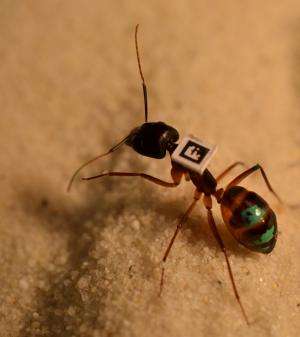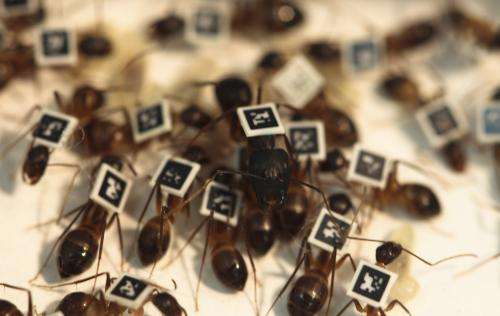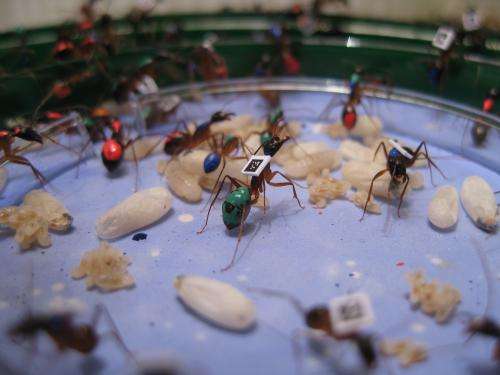April 19, 2013 report
Researchers glue bar codes on to ants to study individual behavior within group (w/ video)

(Phys.org) —A team of researchers made up of two behavioral ecologists from the University of Lausanne and a robotics engineer from the Swiss Federal Institute of Technology has developed a novel way to study the behavior of individual ants in a colony—they've glued bar codes to their backs which they scan from above. In their paper published in the journal Science, the group describes how their groundbreaking approach has led to new discoveries about how ants behave.
Laurent Keller is very well known in biology circles for his work in studying fire ants over the past 20 years. Today, he runs a lab in Lausanne dedicated to trying to understand how and why ants behave the way they do. In this new effort, one of his former students, Danielle Mersch began looking for a way to track individual ants in a colony over many days. Traditional approaches, such as color coding didn't allow for nearly enough information capture so Mersch and Keller enlisted the assistance of Alessandro Crespi, a robotics engineer. Together the team devised a means for gluing tiny paper bar codes onto the backs of every ant in a colony, then scanning them from above (taking snaps twice per second). The data from the scans was fed into a computer which noted the position of every ant in a colony at a given moment in time—that allowed for tracking the movements of each individual ant over a period of time. Once the system was in place, the team used it to track the movement of ants in six colonies, each of which had approximately 100 members, over periods of 41 days each.
In analyzing the behavior of the ants they were studying, the researchers were able to note interactions between the ants (over 9 million in total) and to follow how the roles they filled in the colony changed as the ants grew older. They discovered that there were three basic jobs or roles for the ants in the colony: caretaker, cleaner and forager. They found also that interaction between members who performed the same duties was very high, whereas interactions between members who performed different functions, was limited. They also found that as the ants grew older, they quite often switched jobs. For the most part, they noted, caretaking was a job for the youngest ants—most eventually graduated to becoming cleaners, and then eventually to foragers.


The novel approach developed by the team is likely to be adopted by others studying the behavior of individuals in groups—offering the possibility of developing new theories regarding social behavior in general.
More information: Tracking Individuals Shows Spatial Fidelity Is a Key Regulator of Ant Social Organization, Science DOI: 10.1126/science.1234316
ABSTRACT
Ants live in organized societies with a marked division of labor among workers, but little is known about how this is generated. We use a tracking system to continuously monitor individually tagged workers in six colonies of the ant Camponotus fellah over 41 days. Network analyses of over 9 million interactions revealed three distinct groups that differ in behavioral repertoires. Each group represents a functional behavioral unit with workers moving from one group to the next as they age. The rate of interactions was much higher within than between groups. The precise information on spatial and temporal distribution of all individuals permitted calculation of the expected rates of within- and between-group interactions. These values suggest that the network of interaction within colonies is primarily mediated by age-induced changes in the spatial location of workers.
Journal information: Science
© 2013 Phys.org



















